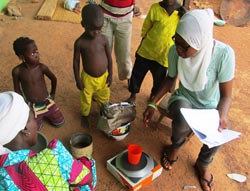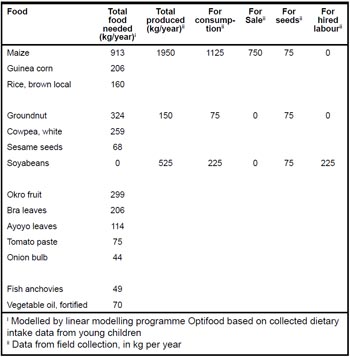In my PhD research I assess whether the food requirements of rural households in Ghana match with the food they produce. Therefore I need to know how much and which food the household members need for a healthy diet, and how much and which food they produce on their farm. To see what food is needed for a healthy diet, together with a team of scientists, research assistants and students1 I collected dietary intake data from 400 children between 6 months and 2 years old in Karaga district in Northern Ghana. To see what food is produced, we collected data on what crops are produced and in what quantities during the previous year.
Currently, the ‘golden standard’ to measure dietary intake at population level is a quantitative 24 hour recall. To estimate dietary intake for young children, we asked mothers what their children ate the previous day from the time they woke up until the time they went to bed. We listed all dishes and for each dish, we measured the quantities of all ingredients used to prepare that dish. We collected data for young children because an adequate diet in this age period is extremely important for a healthy adult life. The dietary intake data for young children can then be used to extrapolate the food needed for other household members.
 |
We combine the dietary intake information from the children with their nutrient requirements from the WHO in the linear modelling programme Optifood. Optifood then models the best possible nutrient adequate diet for these children based on commonly consumed foods and the quantities consumed of these foods. To see what and how much food a whole household needs, we use conversion factors2 to extrapolate the modelled best diet for young children to all other household members. |
The table below shows the food needed for Abubakari’s household (first column), how much of the food is needed (second column) and their reported food production (third column) per year. For example, you can see that this household produces more maize than it needs, but also eats more maize than it needs (1125 versus 913 kg per year). However, maize does not contain all the required nutrients for a healthy diet and this household needs to eat other foods as well. Because part of the yield is sold, the income may be used to buy other foods which are needed but not produced.
|
Table: Food needed and food produced in kg per year in Abubakari’s household in North Ghana What are the next steps in this study? The example above of the best nutrient adequate diet unfortunately does not contain all nutrient levels as recommended by the WHO because the model is limited by the common foods that are consumed and the sizes of the portions. Therefore, we will add the N2Africa legumes (groundnuts, cowpea and soyabean) and/or higher portion sizes into the model. Finally, we will add other promising foods from the Ghana food composition table to the model to be able to simulate a diet that does contain all recommended nutrients. We will then have 3 different modelled diets: a locally best possible diet, a locally best possible diet plus N2Africa legumes, and a diet which covers all nutrient needs. By identifying the gaps between food that is needed and food produced, and comparing gaps for all 3 modelled diets, we can identify potential interventions both at farm and at consumption level for a more nutritious diet for all members of Abubakari’s household and all other rural Ghanaian households. |
 |
Ilse de Jager
1 From Wageningen University, the Netherlands and the University of Development Studies, Ghana
2 The conversion factors are based on household roster information and the nutrient requirements for all age groups from the WHO.
